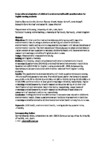Cross-cultural adaptation of children´s environmental health questionnaires for English nursing students
| dc.contributor.author | Álvarez-García, C | |
| dc.contributor.author | Álvarez-Nieto, C | |
| dc.contributor.author | Carter, R | |
| dc.contributor.author | Kelsey, Janet | |
| dc.contributor.author | Sanz-Martos, S | |
| dc.contributor.author | López-Medinaa, I | |
| dc.date.accessioned | 2020-09-16T15:35:04Z | |
| dc.date.issued | 2020-11-01 | |
| dc.identifier.issn | 0017-8969 | |
| dc.identifier.uri | http://hdl.handle.net/10026.1/16371 | |
| dc.description.abstract |
Objectives: Children are among the most vulnerable population groups with regard to environmental risks. Nursing students must be fully educated on children’s environmental health as they are in a key position to prevent and reduce the effects of environmental hazards. The main objective of this study was to adapt and validate an English language version of two questionnaires about children’s health and the environment, to assess the knowledge and skills of student nurses in England. Design: Observational cross-sectional study. Setting: A university in Southern England. Method: The study involves translating, adapting and validating the Children’s Environmental Health Knowledge Questionnaire (ChEHK-Q) and the Children’s Environmental Health Skills Questionnaire (ChEHS-Q) with nursing students in England (N = 232). Results: The psychometric characteristics of both questionnaires were strong. Infit and outfit values were close to 1. The reliability values for the items and people were 0.96 and 0.79 for ChEHK-Q and 0.98 and 0.89 for ChEHS-Q, respectively. Only 52 (22.41%) and 77 (33.62%) participants had at least good knowledge and skills, respectively. Higher knowledge and skills were found with respect to the vulnerability of children and identification of environmental risks in the home. Lower levels of knowledge and skills were found with respect to the effects of pesticides and the assessment of neoplastic pollutants. Conclusion: Findings demonstrate deficiencies in nursing competencies related to children’s environmental health. The use of these questionnaires will facilitate improvement in both knowledge and skills related to children’s environmental health among future nurses. | |
| dc.language.iso | en | |
| dc.publisher | SAGE Publications | |
| dc.title | Cross-cultural adaptation of children´s environmental health questionnaires for English nursing students | |
| dc.type | journal-article | |
| plymouth.journal | Health Education Journal | |
| dc.identifier.doi | 10.1177/0017896920915594 | |
| plymouth.organisational-group | /Plymouth | |
| plymouth.organisational-group | /Plymouth/Faculty of Health | |
| plymouth.organisational-group | /Plymouth/Research Groups | |
| plymouth.organisational-group | /Plymouth/Research Groups/Institute of Health and Community | |
| plymouth.organisational-group | /Plymouth/Users by role | |
| plymouth.organisational-group | /Plymouth/Users by role/Academics | |
| dcterms.dateAccepted | 2020-02-05 | |
| dc.rights.embargodate | 2020-9-18 | |
| dc.rights.embargoperiod | Not known | |
| rioxxterms.versionofrecord | 10.1177/0017896920915594 | |
| rioxxterms.licenseref.uri | http://www.rioxx.net/licenses/all-rights-reserved | |
| rioxxterms.licenseref.startdate | 2020-11-01 | |
| rioxxterms.type | Journal Article/Review |


